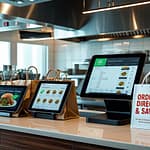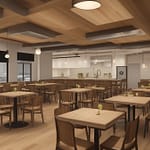Key Takeaways:
- Consider demographic data, such as population density and income levels, to ensure your restaurant caters to the right audience.
- Evaluate the accessibility and visibility of the site, important for attracting both foot and vehicular traffic.
- Analyze the competition in the area to understand market saturation and identify potential differentiation strategies.
- Assess the availability of necessary utilities and infrastructure, such as water, electricity, and parking facilities.
- Examine local laws and regulations that may impact your restaurant’s operations, such as zoning laws and licensing requirements.
How to Choose the Right Location for Your Next Branch
Opening a new restaurant location is an exciting step toward growth and expansion, but it’s also one of the most critical decisions you’ll make as a restaurant owner. A well-chosen location can significantly boost your brand visibility, customer traffic, and overall profitability. Conversely, a poorly selected site could lead to underperformance and unnecessary financial strain. With so much at stake, how can you ensure you’re choosing the ideal spot?
In this article, we’ll explore essential factors to consider when selecting your next restaurant location. We’ll provide practical, actionable advice to help you navigate this crucial decision and support your long-term success.
Understanding Your Target Market
Before you even begin scouting locations, it’s vital to have a thorough understanding of your target customers. Knowing who your audience is, their dining preferences, and their typical behaviors will help you pinpoint ideal geographic areas.
Demographic Analysis
Analyze demographic data such as age, income levels, family size, and lifestyle preferences. For instance, if your restaurant targets young professionals, locating near business districts or urban residential areas with a high concentration of this audience makes sense. Conversely, family-friendly establishments perform better in suburban neighborhoods with schools and parks nearby.
Psychographic Factors
Beyond demographics, psychographic profiling—studying customers’ attitudes, interests, and lifestyles—can help refine your location search. A health-focused café, for example, would thrive near fitness centers, yoga studios, or walking trails, aligning with the lifestyle choices of health-conscious patrons.
Visibility and Accessibility
Visibility and accessibility significantly influence customer convenience and your restaurant’s foot traffic. Even the best menus and service can’t compensate for a hidden or hard-to-access location.
Visibility to Passersby
The ideal restaurant site is easily visible to pedestrians and motorists. High-traffic roads, busy intersections, or locations adjacent to popular retail areas and malls provide strong visibility. Ensure signage opportunities are ample and clear from multiple vantage points.
Ease of Access and Parking
Customers value convenience. Analyze how easy it is for customers to reach your restaurant by car, public transit, or foot. A location with ample parking or proximity to public transportation hubs will encourage frequent visits and repeat business.
Assessing Competition and Market Saturation
Competition analysis is vital when selecting a new restaurant location. While some competition can indicate a healthy market, excessive saturation can limit potential profitability.
Evaluate Direct Competitors
Identify restaurants in the area serving similar cuisine or target demographics. Assess how established these competitors are and their market share. If competitors are thriving, your concept must offer unique value or differentiators to capture market share effectively.
Consider Complementary Businesses
Restaurants often benefit from nearby complementary businesses. For example, locating near entertainment venues, cinemas, or shopping centers can drive additional customer traffic. Evaluate the neighborhood’s business ecosystem to determine if your restaurant aligns well with existing establishments.
Analyzing Foot Traffic and Customer Flow Patterns
Foot traffic analysis provides valuable insights into potential customer volume. Understanding peak times, pedestrian flow, and seasonal traffic patterns enables better forecasting and operational planning.
Peak and Off-Peak Hours
Observe the potential location at various times throughout the day and week. Identify when foot traffic is highest—lunchtime, evenings, weekends—and determine if these patterns align with your business model and concept. For instance, a breakfast café should prioritize locations with significant morning pedestrian flow.
Seasonality and Special Events
Research if the area experiences seasonal fluctuations or hosts special events regularly. Tourist-heavy locations might experience significant seasonal highs and lows, impacting staffing, inventory, and profitability. Conversely, areas hosting regular events or festivals can provide consistent periodic boosts in foot traffic.
Infrastructure and Facility Considerations
The physical characteristics and infrastructure of your chosen location will directly impact your operational efficiency and customer experience. Thoroughly assessing the site’s existing facilities and required upgrades can prevent costly surprises down the line.
Utility and Service Infrastructure
Ensure the site has adequate utility connections, including water, electricity, gas, waste management, and internet services. Verify the capacity to support your kitchen equipment, refrigeration, HVAC systems, and customer Wi-Fi requirements. Upgrading insufficient infrastructure can significantly impact your budget.
Building Condition and Renovation Costs
Inspect the physical condition of the property carefully. Structural issues, outdated electrical wiring, or plumbing problems can lead to unexpected renovation expenses. Consider hiring a professional building inspector to provide an accurate assessment, ensuring you’re aware of all potential renovation costs upfront.
Zoning Regulations and Local Laws
Zoning regulations and local ordinances can significantly influence your restaurant’s operations. Ensuring compliance beforehand can help you avoid legal complications and costly delays.
Zoning Restrictions and Permits
Confirm that the site’s zoning classification permits restaurant operations, including alcohol sales, outdoor seating, signage, and late-night operations as needed. Contact local authorities to verify zoning laws and identify any required permits or licenses.
Community and Neighborhood Sentiments
Engage with local community leaders, neighborhood associations, and residents to understand their perception of new businesses. Gaining community support can greatly aid your restaurant’s successful launch and long-term acceptance within the local market.
Financial Feasibility and Cost Analysis
Perform a comprehensive financial analysis to ensure the location aligns with your budget and long-term profitability goals. Factor in all costs associated with the site, including lease or purchase expenses, renovations, utilities, and ongoing operational expenses.
Lease Terms and Negotiations
Carefully review lease terms, including rent escalations, renewal options, and tenant improvement allowances. Seek favorable terms and negotiate proactively to ensure the lease aligns with your projected revenues and growth strategy.
Projected Revenue and Break-Even Analysis
Conduct financial projections and a break-even analysis based on your anticipated customer volume, pricing, and operating expenses. Accurately estimating potential revenues and identifying how long it will take to cover initial investments is critical to making informed decisions.
Case Study: Chipotle’s Strategic Site Planning
Chipotle Mexican Grill serves as an excellent example of strategic restaurant location planning. Known for meticulous site selection, Chipotle often chooses locations near high-foot-traffic areas, college campuses, and urban commercial districts. By selecting sites based on detailed demographic analysis, accessibility, and visibility, Chipotle has successfully expanded its national presence while maintaining consistent brand standards and profitability.
Conclusion
Choosing the right location for your next restaurant branch requires careful analysis, strategic planning, and thorough due diligence. By understanding your target market, evaluating visibility and accessibility, assessing competition, and carefully considering infrastructure and financial feasibility, you can maximize your chances of success. Remember, your restaurant’s location is more than just an address—it’s an integral part of your brand experience, customer loyalty, and long-term profitability.






Comments
Be the first to comment on this article.